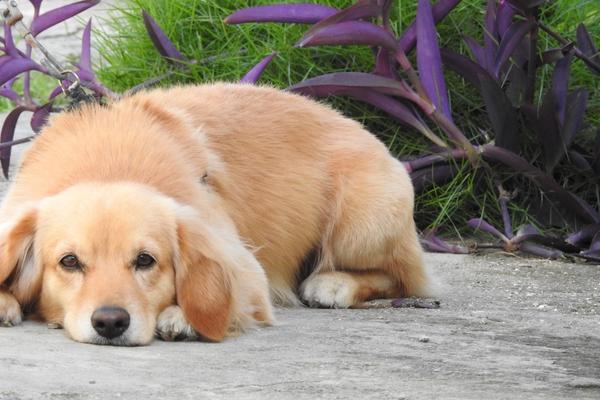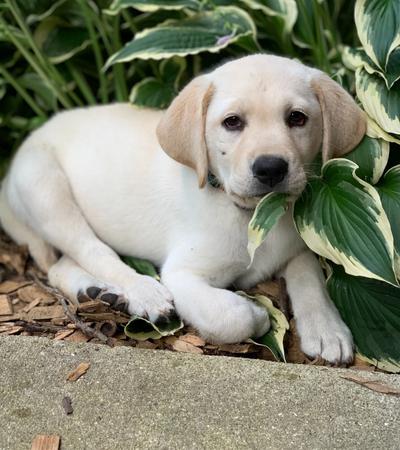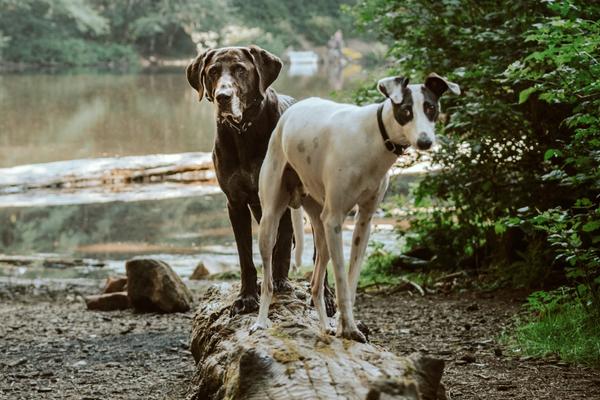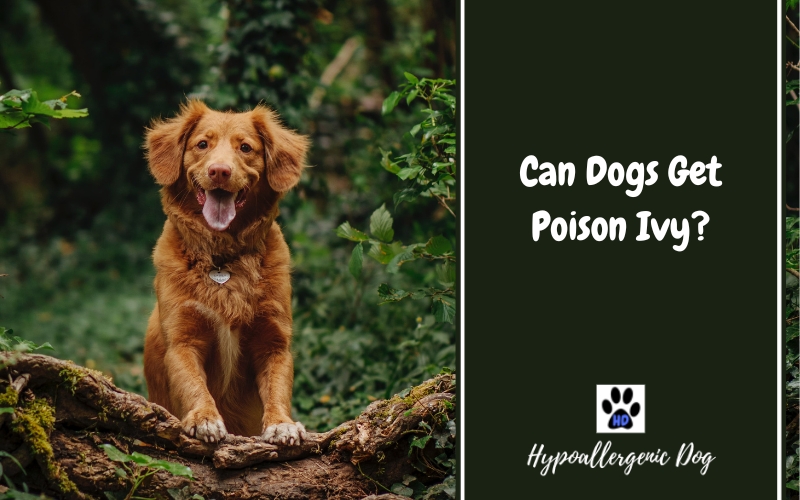Can dogs get poison ivy? A reaction to poison ivy is very common in us humans, but is it the same for our furry friends?
This notorious plant wreaks havoc on us, and for that, we give it a wide berth at every opportunity. However, our four-legged friends are inquisitive creatures and may not follow suit.
Has your pooch come into contact with poison ivy during walkies today and you’re unsure if you need to be worried or not? Whatever questions you have about dogs and poison ivy, we’ve got the answers.
What Is Poison Ivy?
Poison ivy is a Toxicodendron plant originating in North America and Asia. The plant can be found in marshland and wooded areas. Despite the name, poison ivy plants aren’t poisonous.
However, this plant does produce urushiol, a sticky oil that’s responsible for triggering an allergic reaction in humans. Even coming into contact with the smallest amount of this substance can cause unpleasant symptoms.
Common poison ivy symptoms in humans include:
- Skin irritation.
- Swelling.
- Red rash.
- Blisters.
- Severe itching.
However, you’re not here because you want to know how it affects humans, are you? You’re reading this because you want to know about dogs and poison ivy, so let’s get to it!
Does Poison Ivy Affect Dogs?
While research has shown approximately 4 out of 5 people react and develop a rash after being exposed to poison ivy, this isn’t the case for our canine companions.
It’s all too easy for dogs to come into contact with poison ivy, especially if they spend a lot of time enjoying walks in the woods. Your dog can brush up against this plant, step on it or even decide to munch on it as a mid-walk snack!
Although your pooch has a high risk of exposure, they’re unlikely to suffer the itchy consequences. Thanks to your dog’s coat, the urushiol oil is unlikely to reach their skin and cause a reaction. If the oil settles on their fur, it’s unlikely to penetrate down through their coat and start irritating their skin.
However, parts of your dog are more vulnerable to poison ivy than others. Dogs have less fur on their underside, and if their belly comes into contact with a poison ivy plant, your dog may become itchy and unwell.
This is also the case for breeds with less fur all over their body, as more of their skin can come in contact with the plant.

Dog Poison Ivy Symptoms
Dog poison ivy allergic reactions may be rare, but all dog owners should know what signs to look out for. If your dog ate poison ivy during walkies today, or your pup’s skin came into contact with this toxic plant oil, here is a list of dog poison ivy symptoms:
- Blisters.
- Red rash.
- Raised bumps.
- Swelling.
- Inflammation.
- Severe itchiness.
- Excessive biting and scratching (rash area).
- Stomach pain.
- Vomiting.
- Diarrhea.
Reactions caused by poison ivy on a dog’s belly or other areas of vulnerable skin are generally mild, and your dog should make a full recovery.
Can Dogs Eat Poison Ivy?
While on the whole, a reaction to poison ivy isn’t serious, the real problems can occur if your dog ingests the plant. They could go into anaphylactic shock.
Anaphylactic shock is a severe and life-threatening allergic reaction. If your dog experiences anaphylaxis, they will have extreme difficulty breathing, and their throat may swell so much that it closes up entirely. It’s a sad fact that if not treated swiftly enough, it can be fatal.
To learn more about this emergency, read our guide on Anaphylactic Shock in Dogs.
So, if you enjoy hiking and walking in the woods with your canine companion, try to avoid poison-ivy-prolific areas. Always err on the side of caution and keep them away from this plant.
How To Treat Poison Ivy on Dogs
If your pooch has come into contact with poison ivy, try not to beat yourself up! Dogs are curious creatures, and their love of exploring can sometimes get them into trouble. When a dog has been exposed to urushiol, there are several steps you can take to keep them — and you — safe from an allergic reaction.
Bathe Them as Soon as Possible
If you’ve been hiking in a wooded area and think your dog may have come into contact with poison ivy, try not to touch them and wash them as soon as you can. Oatmeal-based shampoos are effective in removing the oil from poison ivy, but you may need to wash your dog a few times to make sure all the oil has been removed.
To reduce your own risk of coming into contact with the urushiol, wear gloves when you’re washing your dog.
Clean Everything Your Dog Has Touched
Anything that’s potentially been exposed to the toxic oil must be thoroughly cleaned.
Wash your dog’s collar and leash in hot water, and also use a fabric cleaner to wash their seat in the car. Plus, don’t forget to wash your own clothes and any blankets or towels your dog has come into contact with. One of the biggest risks of dogs and poison ivy is a canine unknowingly passing the oil onto their owner.
Soothe the Itching
Bathing your dog will not only remove urushiol from their coat, but help to soothe itching too. As well as a bath, you can apply coconut oil to the inflamed area or use a topical hydrocortisone cream.
Steroid creams can only be given by a vet, so make an appointment for your dog if they aren’t coping with the itching and irritation. Seek professional advice before applying any creams or home remedies to your dog’s poison ivy rash.
Call the Vet
Sometimes dogs require additional dog poison ivy treatment. Your vet may need to give your pooch a topical steroid cream to alleviate itching and reduce inflammation.
In rare circumstances, your dog may have to take steroid medication or an injection to treat a more severe allergic reaction. If you notice your dog is struggling to breathe, this is an emergency — your dog requires urgent treatment for anaphylaxis.
What’s more, a poison ivy reaction can lead to a secondary skin infection caused by excessive scratching. If your pooch develops an infection, they will be treated with antibiotics.

What Plants To Avoid If You Have a Dog?
Poison ivy isn’t the only plant you want to keep away from your dog. We know bow-wows love to sniff around and explore, but many indoor and outdoor plants are not dog-friendly.
Azaleas
When ingested, azaleas can cause a bad stomach upset for your pooch. These plants contain grayanotoxin, which if your dog eats a lot of them, they may become seriously ill. Azaleas can cause dogs to become extremely weak, experience a drop in blood pressure, and develop an irregular heart rate.
Cyclamen
This pink and popular house plant, cyclamen is toxic to dogs. Eating the flowers can induce vomiting and diarrhea. However, eating the roots can impact their heart rate, and this may be fatal.
Lily of the Valley
There is no denying the beauty of these popular flowers, but you mustn’t allow your dog anywhere near them. Eating any part of a lily could cause your dog to have a seizure, become extremely sick, and even fall into a coma. Lily of the valley plants can disrupt your dog’s natural heart rate and rhythm, which can lead to death.
Tulips
The bright and pretty tulip is a popular plant that offers a burst of color in gardens during springtime. Yet, your pup shouldn’t be allowed to eat it. If your dog chomps down freshly planted bulbs, they can develop a loss of appetite, a seriously upset stomach and become depressed. The leaves aren’t as toxic, but can still cause sickness for your pup.
Philodendrons
A philodendron is a very popular house plant and its heart-shaped leaves are pretty to look at but are no good for our furry friends. If your dog eats the leaves of this plant, the insoluble calcium oxalate crystals can irritate their mouth.
Other Poisonous Plants for Dogs
Several plants are toxic for dogs and if we detailed them all, you’d be here all day. So, here’s a run-through of a few common horticultural hazards for canines.
- Arum.
- African wonder tree.
- Aloe.
- Baby doll ti plant.
- Barbados pride.
- Butterfly iris.
- Calamondin orange.
- Calla lily.
- Caraway.
- Daffodil.
- Dahlia.
- Daisy.
- Eastern star.
- Elephant ears.
- Elephant-ear begonia.
- Good luck plant.
- Sacred bamboo.
- Christmas rose.
- Holly.
- Hops.
- Horse chestnut.
- Laurel.
- Lavender.
- Lemon grass.
Conclusion
If your dog gets urushiol oil on their coat, they’re unlikely to have a reaction -— but you can’t rule it out completely. If the oil comes into contact with their skin, inflammation can occur and cause excessive itching.
Eating poison ivy can also cause your pooch to become unwell. The best thing you can do to keep your dog safe is to keep them away from this plant when you head out for walkies in the woods.
Can dogs get poison ivy? Yes, it’s possible. Our furry friends don’t suffer as badly as us humans, but canines can develop a rash when exposed to poison ivy.

Can Dogs Get Poison Ivy? FAQs
Can Dogs Get Poison Ivy if They Lick It?
Wondering what happens if a dog licks poison ivy? The truth is, your dog will likely only experience a mild stomach upset if they lick a leaf. Ingesting the plant is more serious — it can lead to sickness and diarrhea.
Can I Get Poison Ivy From My Dog
Yes, you can get poison ivy from a dog. If your dog has urushiol oil on their coat after coming into contact with a poison ivy plant, this can contaminate your skin when you pet them. Hence, if your dog has been rubbing against poison ivy, you must bathe them as soon as possible, this will reduce your risk of exposure.
How Long Does It Take for Poison Ivy To Show Up on Dogs?
Dogs typically experience allergic reaction symptoms approximately three to 7 days after being exposed to poison ivy.
Can I Give My Dog Benadryl for Poison Ivy?
In most circumstances, a poison ivy rash on your dog will go away on its own, and you don’t need to do anything. However, with your vet’s professional guidance, you may be able to give your dog an antihistamine medication like Benadryl. This will ease your dog’s symptoms and reduce skin irritation.
What Happens if Dogs Touch Poison Ivy?
Here’s how to get rid of poison ivy on dogs:
- Get them home and in the bath as soon as possible.
- Wash your dog several times with an oatmeal shampoo to remove the poison ivy oil from their coat and skin.
- Wear gloves while you’re washing your dog to avoid getting any urushiol on your own skin.
- If you’re worried about your dog, a vet can provide you with advice on how to care for your pooch and provide treatment if necessary.
What Does Poison Ivy Look Like on a Dog’s Skin?
There are a few key things to look out for on your dog’s skin if they have poison ivy, and that is:
- Red skin.
- Swollen skin.
- Blisters.


